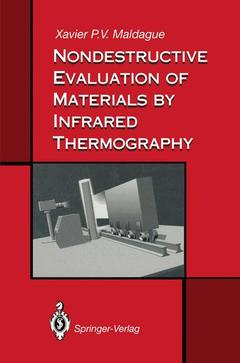Nondestructive Evaluation of Materials by Infrared Thermography, Softcover reprint of the original 1st ed. 1993
Langue : Anglais
Auteur : Maldague Xavier P.V.

With national trade barriers falling, causing the expansion of the com petitive global market, the question of quality control has become an essential issue for the 1990s. The time where the promise was to replace a product if it does not work seems to have passed; what is more impor tant now is not so much a reduction in what is going wrong but an increase of what is going right the first time (Feigenbaum 1990). This new trend is sometimes referred to as total quality. Among the many advantages ofthis zero-defect manufacturing policy, we can enumerate (Laurin 1990): superior marketability of wholly de pendable products, enormous gain in productivity, elimination of waste ful cost in replacing poor quality work and retrofitting rejected products from the field. Although total quality is a relatively new and attractive concept for mass products such as cars, consumer electronics and per sonal computers, in many fields, mainly aerospace and military, it has been the rule for years because of security reasons.
1 Overview of Nondestructive Evaluation (NDE) Using Infrared Thermography.- 1.1 General Considerations.- 1.1.1 Short History of the Infrared.- 1.1.2 Various Instruments for Temperature Measurement.- 1.2 Active and Passive Approaches in TNDE.- 1.2.1 Passive Approach.- 1.2.2 Active Approach.- 1.3 New Materials.- 1.3.1 General Considerations.- 1.3.2 NDE Techniques for New Materials.- 1.3.3 Bonded Assemblies.- 1.3.4 Graphite Epoxy Structures.- 1.4 Detectors for Infrared Imaging.- 1.4.1 Thermal Detectors and Cameras.- 1.4.2 Photonic Detectors and Cameras.- 1.5 TNDE: Pros and Cons.- 2 Theoretical Aspects.- 2.1 Radiometry.- 2.2 Heat Transfer Modelling.- 2.2.1 Analytical Approach.- 2.2.2 Finite Difference Modelling.- 3 Experimental Apparatus.- 3.1 Description of the System and Intended Use.- 3.1.1 Infrared Cameras and Infrared Images.- 3.1.2 Selection of an Operating Wavelength Band.- 3.1.3 Acquisition and Analysis Equipment.- 3.1.4 Signal Recording.- 3.1.5 Measurement Reproducibility.- 3.1.6 Example of Analysis for an Experimental Set-up.- 3.2 Acquisition Process: Signal Restoration.- 3.2.1 Image Degradation.- 3.2.2 Noise.- 3.3 System Calibration.- 4 External Thermal Stimulation: Methods and Image Processing.- 4.1 General Considerations.- 4.1.1 Automatic Versus Manual Inspection.- 4.1.2 False Colour Image Coding.- 4.1.3 Different Types of Materials.- 4.2 Study of Graphite Epoxy Composites: Procedures, Investigation, Processing.- 4.2.1 Impact Damage.- 4.2.2 Evaluation of Fibre Content in Graphite Epoxy Composites.- 4.2.3 Delaminations.- 4.3 Study of Aluminium Laminates: Procedures, Investigation, Processing.- 4.3.1 General Considerations.- 4.3.2 Static Configuration.- 4.3.3 Mobile Configuration.- 4.4 Automatic Defect Detection.- 4.4.1 General Considerations.- 4.4.2 Image Formation.- 4.4.3 Automatic Segmentation Algorithm.- 4.4.4 Results and Discussion.- 5 Internal Thermal Stimulation: Methods and Image Processing.- 5.1 General Considerations.- 5.2 Case Study I: Evaluation of Corrosion Damage to Pipes.- 5.3 Case Study II: Inspection of Jet Turbine Blades.- 5.3.1 Experimental Analysis.- 5.3.2 Thermal Signature Analysis.- 5.3.3 Discussion.- 6 Quantitative Analysis of Delaminations.- 6.1 General Considerations.- 6.2 The Inverse Problem.- 6.2.1 A Practical Numerical Approach.- 6.2.2 Normalized Variables.- 6.3 Experimental Procedure: Thermogram Processing.- 6.3.1 Thermal Contrast.- 6.3.2 Logarithmic Time Scale.- 6.3.3 Practical Computation of C(t), Cmax, tc?1/2max, tc?max, tc? max l/2.- 6.3.4 Defect Shape Extraction.- 6.4 Discussion on the Quantitative Characterization Procedure.- 7 Inspection of Materials With Low Emissivity by Thermal Transfer Imaging.- 7.1 General Considerations.- 7.2 Thermal Transfer Imaging.- 7.3 Physical Behaviour of Thermal Transfer Imaging Technique.- 7.4 Experimental Results.- 8 Thermal Diffusivity Measurements of Materials.- 8.1 General Considerations.- 8.2 Classical Thermal Diffusivity Measurement Method.- 8.3 Diffusivity Measurement Method Based on the Laplace Transform.- 8.4 Diffusivity Measurement Method Based on Phase Measurement.- 9 Thermal Tomography.- 9.1 General Considerations.- 9.2 Method.- 9.3 Some Results.- 10 Thermal NDE of Nonplanar Surfaces.- 10.1 General Considerations.- 10.2 Principle of Surface Curvature Correction.- 11 Applications of Infrared Thermography to High Temperatures.- 11.1 Detection of Rolled-in Scale on Steel Sheets.- 11.2 Thermal Inspection of High Temperature Industrial Structures.- Appendix A Computer Model.- Appendix B Smoothing Routine.- Appendix C Parabola Computation.- Appendix D Higher Order Gradient Computation Based on the Roberts Gradient.- References.
Date de parution : 11-2011
Ouvrage de 207 p.
15.5x23.5 cm
Disponible chez l'éditeur (délai d'approvisionnement : 15 jours).
Prix indicatif 52,74 €
Ajouter au panierThèmes de Nondestructive Evaluation of Materials by Infrared... :
© 2024 LAVOISIER S.A.S.



